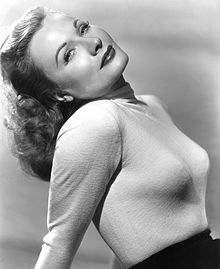Tokyo File 212
George Breakston wrote the film's script and co-produced it with Dorrell McGowan jointly under the banner of their newly formed Breakston–McGowan Productions and Japanese Tonichi Enterprises Company [ja].
Californian lawyer Melvin Belli executive-produced the feature while composer Albert Glasser provided the film's score.
The film, a Japanese-American co-production, starred Florence Marly and Robert Peyton in the lead roles while Tetsu Nakamura played the antagonist.
The plot revolved around an American Intelligence agent (Peyton) sent to Japan to track down a suspected communist who was previously his college-mate (Haida).
Upon release the film received mixed reviews from critics who found the story unconvincing, though they appreciated the scenic settings.
U.S. intelligence agent Jim Carter is sent to Japan as a National Weekly Indicator journalist to find Taro Matsudo who is helping the Communists there.
[1] George Paul Breakston, who had appeared in It Happened One Night (1934) and The Grapes of Wrath (1940) as a child actor, worked in the Signal Corps during World War II and also visited Tokyo.
After the war ended, Breakston shifted his focus towards films, directing Urubu: The Story of Vulture People (1948) and Jungle Stampede (1950).
[9] Contemporary newspaper reports indicated that Leif Erickson and Sessue Hayakawa were also considered for the protagonist and antagonist's roles respectively.
[1][10] Florence Marly, due to star in a big-budget Mexican feature and under contract with Allied Artists at that time, was borrowed for the film.
The blast caused Dorrel McGowan to fall on his back and alarmed the city's air patrol and the military police, fire wagons along with riot squads rushed to the shooting location.
[16] The communists did not want its filming to occur and their threats made the Japanese cast and crew members unwilling to work unless more security was provided.
[17][18] She gave instructions in kissing to five Japanese actors, including Toru Abe and Teiji Takahashi, at Meguro Gajoen hotel during a press conference.
[19][20] This incident did not go down well with some sections of the Japanese who loathed Abe for being kissed by a foreigner and even accused him of bringing shame to the nation.
[2][23] Gen. Douglas MacArthur and the Japanese emperor Hirohito were invited to attend the former event at Tokyo's Ernie Pyle theatre.
Reviewer from Monthly Film Bulletin found the Japanese settings "interesting", but called the story confusing and felt that the depiction of communist activities was childishly silly.
[40] The Christian Science Monitor's reviewer was of the view that the work was "more or less routine entertainment" but praised Marly's "expert job" and the Japanese settings.
However, he felt that the dialogues in Japanese language were a little confusing and Peyton's performance was not worth arousing sympathy for its "professional detachment" and "unemotional determination".
[41] The Washington Post's critic Richard L. Coe termed the film a "low-level, pulp magazine job" and a "less worthy buck-catcher" but felt that it had advantage of realistic settings.
He called the story "comic-strip level" fiction, Peyton's performance "[stony]", criticized the "muscular and uninspired" acting and dialogues.
"[43] John L. Scott wrote in Los Angeles Times that the "production moves slowly and abrupt cutting doesn't help the matter much" and termed the picture a "routine spy business".
[44] For Eiga no tomo's editor Nagaharu Yodogawa who called it a "failure", viewing the feature was a "truly painful" experience.
[46] The Newcastle Sun called it a "rather unusual film", its background atmosphere "excellent" and praised Marly's performance.
[47] James King wrote in his book Under Foreign Eyes that Korea and Communist menace was underscored and the Japanese characters were portrayed as having conflicting emotions with the Western ones.
[50] In his book Korean War Filmography, Robert J. Lentz stated that Marly had given the film's "best performance" and made the feature worth watching.
[51] He was surprised that a few more shots of "scenic Tokyo" had not been included and called the Communist bar scene "unintentionally comic".
Lentz was critical of the script,[52] likened Peyton's voice to that of a TV series actor and rated the film, best of the three produced by Breakston.


